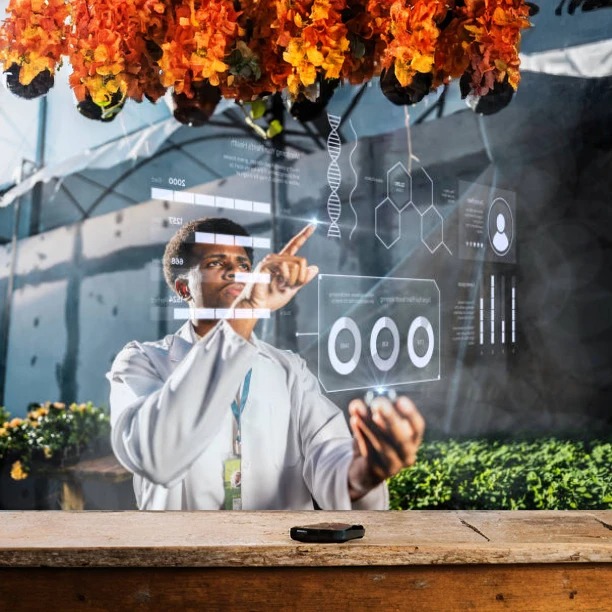Picture this: You’re sitting at home, scrolling through your favorite social media app when you try on a new pair of virtual sunglasses—instantly seeing how they look on your face without even having to leave your chair. Or perhaps you’re looking to buy a new sofa and want to see how it will look in your living room. With a simple tap on your phone screen, the sofa appears, perfectly sized and placed right in front of you. What if you could see an artist’s brush strokes materializing in mid-air while you’re attending a live painting workshop?
This is not magic. It’s Augmented Reality (AR)—a technology that is changing the way we interact with the world around us by blending digital elements into our physical environment.
What Exactly is Augmented Reality?
At its core, Augmented Reality is a technology that superimposes digital content (such as images, videos, sounds, or 3D models) onto the real-world environment, enhancing our interaction with the world. Unlike Virtual Reality (VR), which completely immerses you in a digital space, AR adds layers of digital enhancements to the real world, making it interactive and engaging.
In simpler terms:
Augmented Reality = Real World + Digital Layer.
It’s the bridge between the tangible world and the virtual world, transforming everyday experiences into something more interactive, engaging, and informative.
How Does Augmented Reality Work?
AR works by blending real-time data with computer-generated graphics. Here’s a step-by-step breakdown of the process:
- Input Devices: AR typically works through smartphones, tablets, smart glasses (like Microsoft HoloLens or Magic Leap), and even AR headsets.
- Camera & Sensors: These devices use their camera to scan the real world and gather spatial information, identifying the surfaces, shapes, and objects in the environment.
- Processing: The AR software then processes this information, recognizing specific objects or locations and figuring out how to display the digital content on them.
- Display: The digital elements are overlaid onto the real-world environment via the device’s screen or glasses, creating an interactive experience for the user.
- Interaction: The user can interact with these virtual objects, which can move, resize, or change based on the user’s actions.
For example, when you try on virtual makeup through an app, the app uses your camera to analyze your face, then adds digital makeup layers on top of your real face, allowing you to see how different shades or styles look.
Types of Augmented Reality
AR can be classified into several types based on how it’s experienced and used:
- Marker-Based AR
This is the most common form of AR. It uses markers (like QR codes or specific images) to trigger the display of digital content. For example, pointing your smartphone camera at a logo could make an animation pop up on the screen. - Markerless AR
Unlike marker-based AR, markerless AR doesn’t rely on specific markers or images. Instead, it uses geolocation or environment mapping to trigger content. Pokémon Go is a perfect example, where your location in the real world determines the type of Pokémon you encounter in the game. - Projection-Based AR
This type projects digital light onto physical surfaces to create an interactive experience. It can project a virtual keyboard onto a flat surface, allowing you to type without a physical keyboard. - Superimposition-Based AR
In this type, AR can replace or augment the appearance of an object with virtual elements. For example, you might look at a real-world product through your device, and AR will show extra information about it, like specifications or reviews.
Benefits of Augmented Reality
AR is not just a flashy feature or a fun game—it’s a powerful tool that brings numerous benefits across different industries and everyday applications.
- Enhanced User Experience: AR transforms the way we interact with products, information, and environments, making the experience more intuitive and immersive.
- Improved Learning and Training: AR offers practical training experiences that allow users to interact with simulations. In fields like healthcare, AR helps doctors practice surgeries in a safe, virtual environment, while in education, students can explore complex concepts through interactive 3D models.
- Increased Productivity: By integrating real-time data with the physical world, AR helps workers perform tasks more efficiently. For example, maintenance engineers use AR glasses to view real-time data and instructions while fixing machines without needing a manual.
- Better Decision Making: With AR, businesses can visualize data, such as product designs or architectural plans, in real-time, which leads to better decision-making. Real estate agents use AR to show clients virtual tours of properties, while architects use it to visualize buildings before they’re built.
- Engagement and Entertainment: From gaming to marketing, AR creates interactive experiences that capture attention. Whether it’s a Pokémon popping up in your living room or trying out a new pair of shoes virtually, AR offers endless entertainment possibilities.
The Future of Augmented Reality
The future of AR looks incredibly promising, as advancements in 5G technology, AI, and wearable devices will push the boundaries of what’s possible. Here’s a glimpse of what the future holds:
- AR Glasses: The next generation of smartphones might be replaced by AR glasses that offer hands-free augmented experiences. Imagine seeing directions on the street without needing to look at your phone, or having real-time language translation during a conversation.
- Smarter AR Apps: With AI-powered AR, apps will become even more intuitive and capable of recognizing objects and environments in real-time. The future of shopping could mean trying on clothes without entering a store or trying out furniture virtually in your living room before purchasing it.
- Mixed Reality: The combination of AR and VR (Mixed Reality) will create more immersive, interactive environments, where digital elements blend seamlessly with the real world, unlocking endless possibilities in gaming, work, and education.
- Augmented Social Experiences: AR could redefine how we interact socially, whether through virtual meetups or augmented experiences during in-person events, making every interaction richer and more engaging.
Why AR Matters?
AR isn’t just a trend—it’s an innovative technology that is already making a significant impact across various fields. Whether it’s revolutionizing how we shop, learn, work, or play, AR is bridging the gap between the digital and physical worlds in a way that makes everyday experiences more engaging, informative, and efficient.
The power of AR lies in its ability to bring real-time interaction with digital content, enhancing productivity, learning, and entertainment. Its practical applications are vast and only getting more sophisticated.
Conclusion: The Augmented Future
Augmented Reality is no longer a futuristic concept—it’s here, and it’s changing the way we see and experience the world. From healthcare to education, from gaming to retail, AR is helping us interact with information in new ways, bringing digital content into our physical environments, and making our lives more dynamic and interactive.
As technology continues to evolve, AR’s potential will grow, transforming industries, workplaces, and daily activities. The world of AR is just beginning, and it’s an exciting time to be a part of this augmented future.
Are you ready to experience the world through a new lens?

